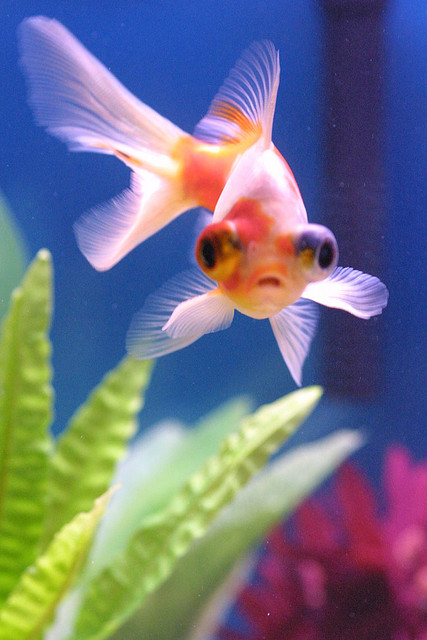

Always place the feeding clip at the same spot. When you feed your Telescope Goldfish vegetables like lettuce and cucumber you can use a feeding clip. Your Telescope Goldfish will eventually get trained that the food can be found on the bottom of the tank and will spend his time carefully looking for that area in his own goldfishes pace. One other method is to use sinking pellets, and always place them at the same spot in the aquarium or pond. Getting your Telescope Goldfish to accept different kinds of food such as pellet, frozen food, flakes and vegetables, One of the best ways is to get the fish used to your hand, this allows you to control exactly how much food your Telescope Goldfish and gets your goldfish to get some food and prevent other fish from stealing it from the goldfish. don't put plants or ornaments with sharp edges in the aquarium or pond, since the Telescope Goldfish can easily damage its eyes on sharp objects.You should make Filter intake tubes covered in aquarium sponge or something comparable to the sponge.

So you should keep your Telescope Goldfish with other Telescope goldfish, or with other fish with equally poor eyesight such as Celestial Goldfish and Bubble Eye Goldfish. Fast fish, such a Oranda Goldfish, Comet Goldfish and Koi, will eat all the food before the Telescope Goldfish get a chance to eat some. Their telescope eyes limit their eye sight they do not see very well. 10 gallons must be the least amount, and the more room you can provide your Telescope Goldfish with, the better the fish will live. The Telescope Goldfish makes a lot of waste, and should be feed several times a day in small portion, the gold fish doesn't have a stomach that is why you should not over feed, they should not be kept in less than 10 gallons of water.

Today you can find different colors like white, red, black-white, red-white, calico colored, chocolate, tri-colored and blue scale Telescope Goldfish. The Telescope Goldfish comes in a variety of colors and sizes, but all Telescope Goldfish have the protruding buggy eyes and the long and flowing fins in common. The fish should have long and flowing fins, and the caudal fin comes in several different types: veiltial, butterfly, normal Oranda tail,and broadtail. The body depth of a Telescope Goldfish should always be larger than 2/3 of the body length. Regardless of the shape of the eyes, they should be always equal in size and protrude outwards.Ī Telescope Goldfish has an egg-shaped body with a double caudal fin. flat eyes are a little flattened at the top. Some Telescope Goldfish have round eyes that look like they will detach from the fish at anytime, while others have more than half of the eye attached to the head. The round eyes can be found in many degrees of attachment to the head of the fish. The dome shaped eyes are wider at the base of the eye and becomes narrower at the top of the eye. The flat eye, the dome shaped eye, and the simple, round eye. There are three eye-shapes that are agreeable to be for the Telescope Goldfish. The Calico Telescope Goldfish is known by several other names as well, such as Globe Eye Goldfish, Dragon Eye Goldfish and the Japanese word Demekin. The Telescope Goldfish derives its name form its large and protruding buggy eyes. Family: Cyprinidae, Life Span: about 15 years, Aquarium Type: Community fish. Minimum Aquarium: 30 Gallons, Water Conditions: 65-75 F, KH 4-20, pH 6.5-7.5 their diet: Omnivore, Origin:Ěsia, Japan, China. Goldfish Care Level: Easy to raise, Temperament: calm, Peaceful, Maximum Length: about 8 inches. Other names: Dragon eyes, Globe-eye Goldfish. Title : Calico Telescope Goldfish Raising and CareĬalico Telescope Goldfish (syn: Carassius auratus gibelio) The Telescope Goldfish derives its name form its large and protruding eyes which was described by Bloch 1782.


 0 kommentar(er)
0 kommentar(er)
